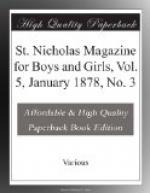Bessie alone, when all the rest
Crushed his spirit with gibe and jest,
Whispered softly, “Whatever they
say,
I know you will build the wheel some day!”
Chirping crickets and singing birds
Were not so sweet as her heartsome words;
Straight he answered, “If ever I
do,
I know it will only be thanks to you!”
Many a time sore heart and brain
Leap at a word, grown strong again.
Thanks to her, as the story goes,
Hope and courage in Jack arose;
Till one bright day in the meadow-brook
There was heard a sound as of water plashing,
And Bessie watched with her happy look
The little wheel in the sunlight flashing.
By and by as the years were fraught
With fruit of his earnest toil and thought,
Brothers and sisters changed their tune,—
“Our Jack,” they cried, “will
be famous soon!”
Which was nothing more than Bessie knew,
She said, and had known it all the while!
But Jack replied with a kiss and a smile,
“If ever I am, it is thanks to you!”
[Illustration]
HOW BIRDS FLY.
BY PROF. W.K. BROOKS.
In our last talk about birds (in ST. NICHOLAS for July), I told you about birds and their nests. Now I wish to say, first, a few words about the different kinds of birds, and then we will see how birds manage to fly. Naturalists have divided the class, birds, into several smaller groups which are called orders. One of these includes the birds of prey, such as the hawks, eagles, and owls. In the picture of a bird of prey you can see the strong, hooked bill and powerful claws, which are well fitted for seizing and tearing its prey.
The second order includes the climbing birds, such as the woodpeckers. The birds of this order can readily be recognized, since two of the toes of each foot point backward, to give support in climbing.
The next order, that of the perching birds, includes all our common song-birds, such as the robin, bluebird, and blackbird, as well as a few larger birds, like the crow.
The scratching birds form another order, including our domestic fowls and many wild game-birds.
The next order comprises the ostrich and a few other large birds, which have such small wings that they are unable to fly, but with very large and powerful legs, so that they are excellent runners. Although this order includes the largest bird at present living, there were formerly running birds very much larger than any which now exist; for, in Madagascar and New Zealand, the bones, and even the eggs, of gigantic birds have been found. One of these eggs was over a foot in length, and contained more than ten quarts or as much as six ostrich eggs or one hundred and fifty hen’s eggs. A nearly complete skeleton of one of these birds has been found, and this must have belonged to a bird fifteen feet high, or taller than the largest elephant!




